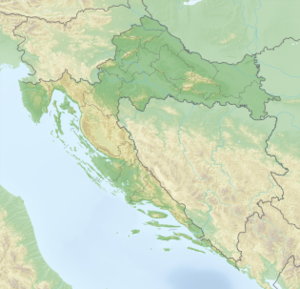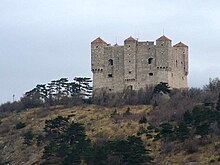Nehaj Fortress
| Nehaj Fortress | ||
|---|---|---|
| Alternative name (s): | Kula Nehaj, Nehajgrad Castle | |
| Creation time : | 16th century | |
| Castle type : | Hilltop castle | |
| Conservation status: | received or received substantial parts | |
| Standing position : | Nobles | |
| Place: | Senj | |
| Geographical location | 44 ° 59 '12.4 " N , 14 ° 54' 11.9" E | |
|
|
||
The Nehaj Fortress , also Kula Nehaj ( Croatian for The Tower Nehaj ) and Nehajgrad (Croatian for The City of Nehaj ), is located on Mount Nehaj in the city of Senj in Croatia ( Lika-Senj County ). It is a well-preserved fortress from the 16th century and was the headquarters of the Uskoks , a military community of Christian (most recently mostly Catholic ) war refugees.
history
The town of Senj was owned by the Croatian Frankopan family until the 15th century . It is not known whether a medieval castle already stood on the mountain at that time.
During the reconstruction of the fortress in 1965, the remains of the Church of St. Juraj from the 11th to 12th centuries were found. It burned down during a Turkish attack in 1520 and the remains of the fortress building were torn down. During the excavations, the so-called Senj tablet was found , a tablet in Glagolitic script from around 1100, which is one of the oldest Croatian written documents.
In 1539 Ivan Lenković Senjer became captain. He reported to the imperial court about the state of the fortifications in the region and advocated the construction of a fortress on the mountain. After the funds were made available by Emperor Ferdinand I , construction of the facility began in 1558. All buildings outside the city of Senj were demolished on the orders of Lenković and the material was used to build the fortress.
The facility has a square floor plan with a side length of 23.5 m and a height of 18 m. 100 loopholes for handguns and eleven artillery loops are arranged on three defensive floors. On the second fortified floor and on the roof platform there are cantilevered half towers ( échauguette ) at all four corners , which enable the flanks to be painted. Inside the fortress there is a narrow courtyard.
Closely linked to the history of the castle is the community of Uskoks, which arose around 1500 community of outlaws that of the Ottomans were driven from their ancestral lands. Their headquarters were initially Klis . After the Turkish conquest of Klis in 1537, Senj became the main base of the Uskoks. The community was able to field up to 1000 armed men. Settled on the border of the Habsburg Empire , they enjoyed the support of the German emperor as a semi-military organization for border security. In this way they were able to maintain their independence for over a hundred years. In the struggle against foreign rule, their opponents were on the one hand the Turks of the Ottoman Empire and on the other hand the Republic of Venice , which had extensive areas on the Dalmatian coast.
The Nehaj Fortress is now state-owned and serves as a museum and excursion destination.
The castle also became known through the classic children's book Die Rote Zora and her gang by Kurt Held . The castle can also be seen in the film .



